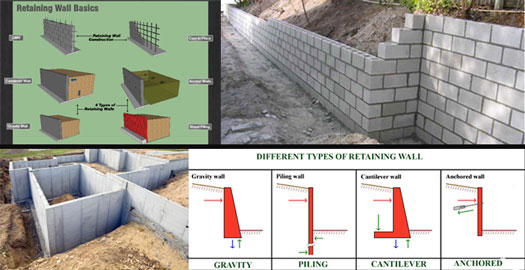Little Known Facts About Ace Construction Company Texas.
Table of Contents9 Easy Facts About Ace Construction Company Austin ExplainedSome Known Incorrect Statements About Ace Construction Company Texas The Definitive Guide to Construction Company AustinTop Guidelines Of Ace Construction Company
Since these products can not withstand considerable stress, the style aims at preventing tension in the wall. Some gravity walls do not utilize mortar, relying solely on their weight to remain in location, as when it comes to dry stone walls. These walls typically are trapezoidal in section as displayed in Fig.2. Gravity walls need heavy foundation due to the plus size of the wall. They are affordable and appropriate for only little heights (construction company austin). A gravity maintaining wall provided with a little quantity of support for lowering the mass of the concrete is referred to as semi-gravity keeping wall, as shown in Fig.
3. The lateral earth pressure is primarily withstood by the mass of the wall, as in the case of a gravity keeping wall. These are the reinforced concrete walls in which lateral earth pressure is resisted by structural action of its members. The base of the wall is extended into the backfill on the heel side and is known as heel piece, as shown in Fig.
4. The backfill over the heel slab supplies considerable additional lateral stability to the wall. The back of the wall on the heel side is also offered a slope. This increases the width of the wall with depth, comparable to the boost in lateral earth pressure with depth. The vertical wall (called stem), the heel slab, and the toe slab serve as cantilevers repaired at their junction and spanning to the other end.
The 7-Second Trick For Ace Construction Company Austin

The heel slab and the toe piece undergo resultant upward soil pressure from the bottom and bend up. Reinforcement is therefore supplied on the tension side, that is, vertically on the backside of the stem and horizontally at the bottom of the heel piece and the toe piece.
Cantilever maintaining walls appropriate for retaining the backfill to moderate heights of 4-7 m. In cross section, the majority of cantilevered walls appear like "L" s or inverted "T" s. Where foundation soils are poor, earth tieback keeping walls are another option. These walls are counterbalanced not only by a large base but also by a series of horizontal bars or strips extending out from the vertical surface into the backfill.
When an earth tieback maintaining wall is backfilled, the weight and friction of the fill versus the horizontal members anchors the structure. When the height of a cantilever maintaining wall is more than about 7 m, it is economical to supply a vertical bracing system, called counterforts, on the backfill side above the heel slab.
16. 5. The stem and the heel slab act as constant pieces covering horizontally along the length of the wall in between the counterforts. Making use of counterforts decreases the bending minute due to earth pressure and hence the size and reinforcement of the stem and the heel piece. Counterforts go through tension due to the action of lateral earth pressure of the backfill on the stem.
The Greatest Guide To Austin Construction Company
Figure 16. 6 reveals an upheld maintaining click here for info wall. The structural action of the stem is the same as in a counterfort keeping wall. However, the heel slab acts as a cantilever slab as in a cantilever maintaining wall. The toe slab acts as a constant slab spanning along the length of the wall in between the buttresses.
ADVERTISEMENTS: Sheet piles are versatile maintaining structures used to offer a temporary building area for building and construction of structures. Sheet stacks are made of lumber, steel, or sometimes strengthened concrete. Lumber sheet piles were used in the past however their reuse is restricted for short-lived structures up to shallow depth. For very important structures and for depth > 3 m, steel sheet piles are more frequently used.
Reinforced cement concrete (RCC) sheet piles may be sometimes utilized in fine sand or soft clays. RCC piles may get damaged or broken under driving stresses in stiff soils. Sheet piles are installed by very first driving the steel or timber sheets into the soil. The soil on the front side is then dredged (removed) out.


Not known Facts About Ace Construction Company
Thus, the depth of foundation (embedment) is big compared to that in a maintaining wall. The density of sheet stacks is really little compared to the depth and length of a wall. Thus, the weight of a sheet pile is really small and is normally ignored in the design. ADS: The soil on the back of the sheet stack is normally eliminated and backfilled with a cohesionless soil. Ace Construction Company Austin.
However, the soil below the dredge level might be either a cohesionless soil or a cohesive soil, depending upon the soil profile at the website of building and construction - Ace Construction Company Austin. Sheet piles having water on article source the front side used in dock and harbor structures to facilitate berthing of vessels (ships) additional resources are known as bulk heads.
Standard sections of steel sheet stacks as suggested by United States Steel (1984) are shown in Table 16. 3. i. Cantilever sheet pile. ii. Anchored sheet stack. The cantilever sheet pile derives its assistance from the embedment into the underlying soil below the dredge level, as revealed in Fig. 16. 11.
When it comes to anchored sheet piles, additional lateral support is provided by ways of anchor rods fixed to the sheet stack near the leading and anchored suitably, as shown in Fig. 16. 12. The lateral stability of anchored sheet stacks is obtained both from the embedment into the soil below the dredge level along with by the support provided by the anchor or tie rod.